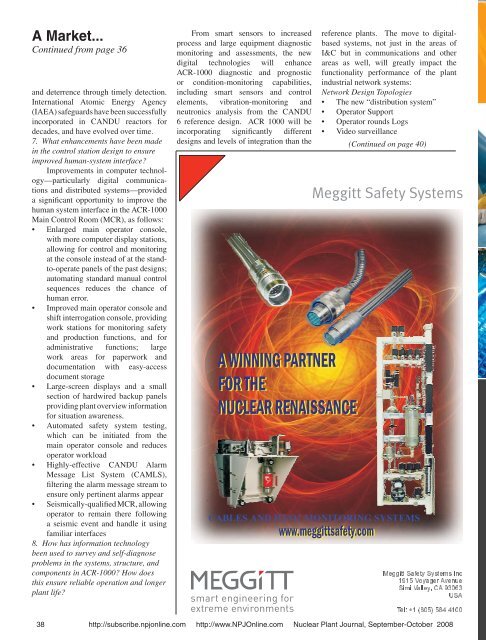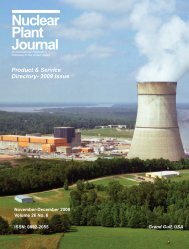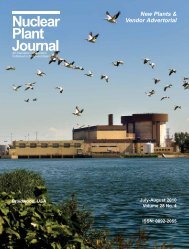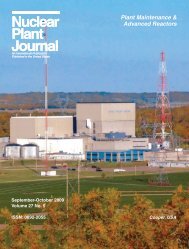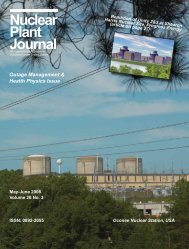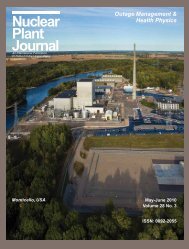Nuclear Plant Journal - Digital Versions
Nuclear Plant Journal - Digital Versions
Nuclear Plant Journal - Digital Versions
You also want an ePaper? Increase the reach of your titles
YUMPU automatically turns print PDFs into web optimized ePapers that Google loves.
A Market...<br />
Continued from page 36<br />
and deterrence through timely detection.<br />
International Atomic Energy Agency<br />
(IAEA) safeguards have been successfully<br />
incorporated in CANDU reactors for<br />
decades, and have evolved over time.<br />
7. What enhancements have been made<br />
in the control station design to ensure<br />
improved human-system interface<br />
Improvements in computer technology—particularly<br />
digital communications<br />
and distributed systems—provided<br />
a significant opportunity to improve the<br />
human system interface in the ACR-1000<br />
Main Control Room (MCR), as follows:<br />
• Enlarged main operator console,<br />
with more computer display stations,<br />
allowing for control and monitoring<br />
at the console instead of at the standto-operate<br />
panels of the past designs;<br />
automating standard manual control<br />
sequences reduces the chance of<br />
human error.<br />
• Improved main operator console and<br />
shift interrogation console, providing<br />
work stations for monitoring safety<br />
and production functions, and for<br />
administrative functions; large<br />
work areas for paperwork and<br />
documentation with easy-access<br />
document storage<br />
• Large-screen displays and a small<br />
section of hardwired backup panels<br />
providing plant overview information<br />
for situation awareness.<br />
• Automated safety system testing,<br />
which can be initiated from the<br />
main operator console and reduces<br />
operator workload<br />
• Highly-effective CANDU Alarm<br />
Message List System (CAMLS),<br />
filtering the alarm message stream to<br />
ensure only pertinent alarms appear<br />
• Seismically-qualified MCR, allowing<br />
operator to remain there following<br />
a seismic event and handle it using<br />
familiar interfaces<br />
8. How has information technology<br />
been used to survey and self-diagnose<br />
problems in the systems, structure, and<br />
components in ACR-1000 How does<br />
this ensure reliable operation and longer<br />
plant life<br />
From smart sensors to increased<br />
process and large equipment diagnostic<br />
monitoring and assessments, the new<br />
digital technologies will enhance<br />
ACR-1000 diagnostic and prognostic<br />
or condition-monitoring capabilities,<br />
including smart sensors and control<br />
elements, vibration-monitoring and<br />
neutronics analysis from the CANDU<br />
6 reference design. ACR 1000 will be<br />
incorporating significantly different<br />
designs and levels of integration than the<br />
A WINNING PARTNER<br />
FOR THE<br />
NUCLEAR RENAISSANCE<br />
reference plants. The move to digitalbased<br />
systems, not just in the areas of<br />
I&C but in communications and other<br />
areas as well, will greatly impact the<br />
functionality performance of the plant<br />
industrial network systems:<br />
Network Design Topologies<br />
• The new “distribution system”<br />
• Operator Support<br />
• Operator rounds Logs<br />
• Video surveillance<br />
(Continued on page 40)<br />
CABLES AND H2/O2 MONITORING SYSTEMS<br />
www.meggittsafety.com<br />
38 http://subscribe.npjonline.com http://www.NPJOnline.com <strong>Nuclear</strong> <strong>Plant</strong> <strong>Journal</strong>, September-October 2008


